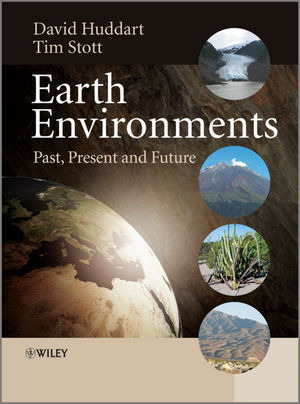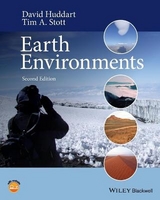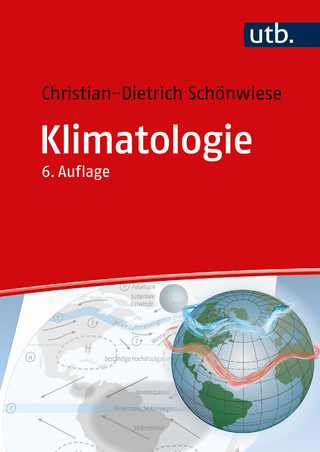
Earth Environments
Wiley-Blackwell (an imprint of John Wiley & Sons Ltd) (Verlag)
978-0-471-48533-9 (ISBN)
- Titel erscheint in neuer Auflage
- Artikel merken
This book provides a comprehensive coverage of the major topics within undergraduate study programmes in geosciences, environmental science, physical geography, natural hazards and ecology. This text introduces students to the Earth's four key interdependent systems: the atmosphere, lithosphere, hydrosphere and biosphere, focussing on their key components, interactions between them and environmental change. Topics covered include: An earth systems model; components systems and processes: atmospheric systems; oceanography, endogenic geological systems and exogenic geological systems, biogeography and, aspects of the Earth's Record. The impact of climate and environmental change is discussed in a final chapter which draws together Earth's systems and their evolution and looks ahead to future earth changes and environments and various time periods in the geological record. Throughout the book geological case studies are used in addition to the modern processes.
Introduction. Section I Introduction to Earth Systems. 1 Introduction to Earth Systems. 1.1 Introduction to the Earth's formation. 1.2 Introduction to Earth spheres. 1.3 Scales in space and time. 1.4 Systems and feedback. 1.5 Open and closed flow systems. 1.6 Equilibrium in systems. 1.7 Time cycles in systems. Exercises. References. Section II Atmospheric and Ocean Systems. 2 Structure and Composition of the Atmosphere. 2.1 Structure of the atmosphere. 2.2 Composition of the atmosphere. Exercises. References. Further reading. 3 Energy in the Atmosphere and the Earth Heat Budget. 3.1 Introduction. 3.2 Solar radiation. Exercises. References. Further reading. 4 Moisture in the Atmosphere. 4.1 Introduction. 4.2 The global hydrological cycle. 4.3 Air stability and instability. 4.4 Clouds. 4.5 Precipitation. Exercises. References. Further reading. 5 Atmospheric Motion. 5.1 Introduction. 5.2 Atmospheric pressure. 5.3 Winds and pressure gradients. 5.4 The global pattern of atmospheric circulation. Exercises. References. Further reading. 6 Weather Systems. 6.1 Introduction. 6.2 Macroscale synoptic systems. 6.3 Meso-scale: Local winds. 6.4 Microclimates. 6.5 Weather obseravtion and forecasting. Exercises. References. Further reading. 7 World Climates. 7.1 Introduction. 7.2 Classification of climate. Exercises. References. Further reading. 8 Ocean Structure and Circulation Patterns. 8.1 Introduction. 8.2 Physical structure of the oceans. 8.3 Temperature structure of the oceans. 8.4 Ocean circulation. 8.5 Sea-level change. Exercises. References. Further reading. 9 Atmospheric Evolution and Climate Change. 9.1 Evolution of the Earth's atmosphere. Exercises. References. Further reading. 10 Principles of Climate Change. 10.1 Introduction. 10.2 Evidence for climate change. 10.3 Causes of climate change. Exercises. References. Further reading. Section III Endogenic Geological Systems. 11 Earth Materials: Mineralogy, Rocks and the Rock Cycle. 11.1 What is a mineral? 11.2 Rocks and the rock cycle. 11.3 Vulcanicity and igneous rocks. 11.4 Sedimentary rocks, fossils and sedimentary structures. 11.5 Metamorphic rocks. Exercises. References. Further reading. 12 The Internal Structure of the Earth. 12.1 Introduction. 12.2 Evidence of the Earth's composition from drilling. 12.3 Evidence of the Earth's composition from volcanoes. 12.4 Evidence of the Earth's composition from meteorites. 12.5 Using earthquake seismic waves as Earth probes. Exercises. References. Further reading. 13 Plate Tectonics and Volcanism: Processes, Products and Landforms. 13.1 Introduction. 13.2 Global tectonics: how plates, basins and mountains are created. 13.3 Volcanic processes and the global tectonic model. 13.4 Magma eruption. 13.5 Explosive volcanism. 13.6 Petrographic features of volcaniclastic sediments. 13.7 Transport and deposition of pyroclastic materials. 13.8 The relationship between volcanic processes and the Earth's atmosphere and climate. 13.9 Relationships between volcanic eruptions and biotic evolution. 13.10 Plate tectonics, uniformitarianism and Earth history. Exercises. References. Further reading. 14 Geotectonics: Processes, Structures and Landforms. 14.1 Introduction. 14.2 Tectonic structures. 14.3 Tectonic structures as lines of weakness in landscape evolution. Exercises. References. Further reading. Section IV Exogenic Geological Systems. 15 Weathering Processes and Products. 15.1 Introduction. 15.2 Physical or mechanical weathering. 15.3 Chemical weathering. 15.4 Measuring weathering rates. 15.5 Weathering landforms. Exercises. References. Further reading. 16 Slope Processes and Morphology. 16.1 Introduction. 16.2 Slopes: mass movement. 16.3 Hillslope hydrology and slope processes. 16.4 Slope morphology and its evolution. Exercises. References. Further reading. 17 Fluvial Processes and Landform-Sediment Assemblages. 17.1 Introduction. 17.2 Loose boundary hydraulics. 17.3 The energy of a river and its ability to do work. 17.4 Transport of the sediment load. 17.5 Types of sediment load. 17.6 River hydrology. 17.7 The drainage basin. 17.8 Drainage patterns and their interpretation. 17.9 Fluvial channel geomorphology. Exercises. References. Further reading. 18 Carbonate Sedimentary Environments and Karst Processes and Landforms. 18.1 Introduction. 18.2 Carbonate sedimentary environments and the creation of carbonate rock characteristics. 18.3 Evaporites. 18.4 Carbonate facies models. 18.5 Karst processes. Exercises. References. Further reading. 19 Coastal Processes, Landforms and Sediments. 19.1 Introduction to the coastal zone. 19.2 Sea waves, tides and tsunamis. 19.3 Tides. 19.4 Tsunamis. 19.5 Coastal landsystems. 19.6 Distribution of coastal landsystems. 19.7 The impact of climatic change on coastal landsystems: What lies in the future? Exercises. References. Further reading. 20 Glacial Processes and Landsystems. 20.1 Introduction. 20.2 Mass balance and glacier formation. 20.3 Mass balance and glacier flow. 20.4 Surging or galloping glaciers. 20.5 Processes of glacial erosion and deposition. 20.6 Glacial landsystems. Exercises. References. Further reading. 21 Periglacial Processes and Landform-Sediment Assemblages. 21.1 Introduction to the term 'periglacial'. 21.2 Permafrost. 21.3 Periglacial processes and landforms. 21.4 Frost heaving and frost thrusting. 21.5 Landforms associated with frost sorting. 21.6 Needle ice development. 21.7 Frost cracking and the development of ice wedges. 21.8 Growth of ground ice and its decay, and the development of pingos, thufurs and palsas. 21.9 Processes associated with snowbanks (nivation processes). 21.10 Cryoplanation or altiplanation processes and their resultant landforms. 21.11 The development of tors. 21.12 Slope processes associated with the short summer melt season. 21.13 Cambering and associated structures. 21.14 Wind action in a periglacial climate. 21.15 Fluvial processes in a periglacial environment. 21.16 Alluvial fans in a periglacial region. 21.17 An overview of the importance of periglacial processes in shaping the landscape of upland Britain. 21.18 The periglaciation of lowland Britain. Exercises. References. 22 Aeolian (Wind) Processes and Landform-Sediment Assemblages. 22.1 Introduction. 22.2 Current controls on wind systems. 22.3 Sediment entrainment and processes of sand movement. 22.4 Processes of wind transport. 22.5 Aeolian bedforms. 22.6 Dune and aeolian sediments. 22.7 Dust and loess deposition. 22.8 Wind erosion landforms. Exercises. References. Further reading. Section V Principles of Ecology and Biogeography. 23 Principles of Ecology and Biogeography. 23.1 Introduction. 23.2 Why do organisms live where they do? 23.3 Components of ecosystems. 23.4 Energy flow in ecosystems. 23.5 Food chains and webs. 23.6 Pathways of mineral matter (biogeochemical cycling). 23.7 Vegetation succession and climaxes. 23.8 Concluding remarks. Exercises. References. Further reading. 24 Soil-forming Processes and Products. 24.1 Introduction. 24.2 Controls on soil formation. 24.3 Soils as systems. 24.4 Soil profile development. 24.5 Soil properties. 24.6 Soil description in the field. 24.7 Key soil types, with a description and typical profile. 24.8 Podsolization: theories. 24.9 Soil classification. 24.10 Regional and local soil distribution. 24.11 The development of dune soils: an example from the Sefton coast. 24.12 The development of woodland soils in Delamere Forest. 24.13 Intrazonal soils caused by topographic change. 24.14 Palaeosols. Exercises. References. Further reading. 25 World Ecosystems. 25.1 Introduction. 25.2 The tundra ecozone. 25.3 The tropical (equatorial) rain forest, or humid tropics sensu stricto, ecozone. 25.4 The seasonal tropics or savanna ecozone. 25.5 Potential effects of global warming on the world's ecozones. Exercises. References. Further reading. Section VI GLobal Environmental Change: Past,Present and Future. 26 The Earth as a Planet: Geological Evolution and Change. 26.1 Introduction. 26.2 How unique is the Earth as a planet? 26.3 What do we really know about the early Earth? 26.4 The early geological record. 26.5 The first Earth system. 26.6 How did the Earth's core form? 26.7 Evolution of the Earth's mantle. 26.8 Evolution of the continental crust. Exercises. References. Further reading. 27 Atmospheric Evolution and Climate Change. 27.1 Evolution of the earth s atmosphere. 27.2 Future climate change. Exercises. References. Further reading. 28 Change in Ocean Circulation and the Hydrosphere. 28.1 Introduction. 28.2 Sea-level change and the supercontinental cycle. 28.3 Ocean circulation in a warming climate. Exercises. References. Further reading. 29 Biosphere Evolution and Change in the Biosphere. 29.1 Introduction. 29.2 Mechanisms of evolution in the fossil record. 29.3 The origins of life. 29.4 An outline history of the Earth's biospheric evolution. 29.5 Mass extinctions and catastrophes in the history of life on Earth. Exercises. References. Further reading. 30 Environmental Change: Greenhouse and Icehouse Earth Phases and Climates Prior to Recent Changes. 30.1 Introduction. 30.2 Early glaciations in the Proterozoic phase of the Pre-Cambrian (the Snowball Earth hypothesis). 30.3 Examples of changes from greenhouse to icehouse climates in the Earth's past. 30.4 Late Cenozoic ice ages: rapid climate change in the Quaternary. 30.5 Late Glacial climates and evidence for rapid change. 30.6 The Medieval Warm Period or Medieval Climate Optimum and the Little Ice Age. Exercises. References. Further reading. 31 Global Environmental Change in the Future. 31.1 Introduction. 31.2 Future climate change. 31.3 Change in the geosphere. 31.4 Change in the oceans and hydrosphere. 31.5 Change in the biosphere. 31.6 A timeline for future Earth. 31.7 Causes for future optimism? 31.8 Concluding remarks. Exercises. References. Further reading. Index.
| Erscheint lt. Verlag | 9.4.2010 |
|---|---|
| Verlagsort | Chicester |
| Sprache | englisch |
| Maße | 210 x 273 mm |
| Gewicht | 2360 g |
| Einbandart | Paperback |
| Themenwelt | Naturwissenschaften ► Geowissenschaften ► Allgemeines / Lexika |
| Naturwissenschaften ► Geowissenschaften ► Geografie / Kartografie | |
| Naturwissenschaften ► Geowissenschaften ► Geologie | |
| ISBN-10 | 0-471-48533-0 / 0471485330 |
| ISBN-13 | 978-0-471-48533-9 / 9780471485339 |
| Zustand | Neuware |
| Haben Sie eine Frage zum Produkt? |
aus dem Bereich



